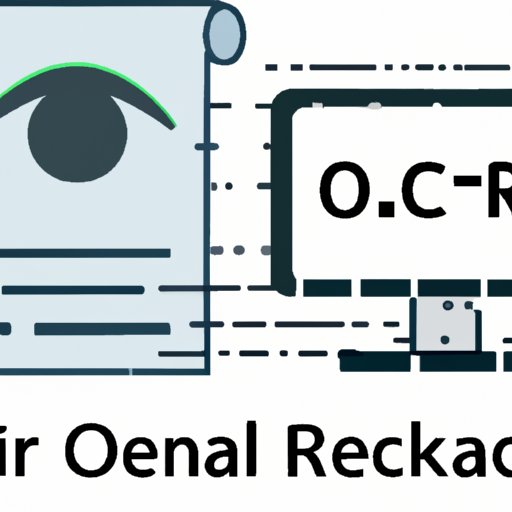Introduction
Optical character recognition (OCR) is a technology that enables computers to recognize text from images or scanned documents. By using this technology, businesses and other organizations can automate tedious tasks such as data entry and document management. OCR also has the potential to revolutionize the way we access information, making it easier to find, interpret, and use data.
The benefits of OCR technology are numerous. It can help reduce costs, improve accuracy, and increase customer satisfaction. In addition, OCR has the potential to transform the way businesses and educational institutions operate, making processes more efficient and streamlined.

How OCR is Transforming Businesses
Businesses are increasingly turning to OCR technology to automate manual tasks such as data entry, document management, and invoice processing. This automation can result in significant cost savings as well as improved accuracy and efficiency. Additionally, OCR technology can help businesses better serve their customers by providing faster and more accurate service.
For example, one study found that using OCR technology to process invoices enabled an organization to reduce their costs by up to 80 percent. The study also found that using OCR technology improved the accuracy of data entry by up to 90 percent. In addition, customers received their invoices much faster, resulting in increased customer satisfaction.
A Detailed Guide to Using OCR Technologies
Using OCR technology is relatively simple, but there are certain steps that must be taken to ensure optimal results. To get started, you will need to select the type of OCR technology that best suits your needs. There are four main types of OCR technology available: optical character recognition (OCR), intelligent character recognition (ICR), intelligent document recognition (IDR), and handwriting recognition (HWR). Each type has its own set of benefits and drawbacks, so it’s important to consider all factors before making a decision.
Once you have chosen the type of OCR technology that best suits your needs, you will need to prepare your documents for scanning. This may involve cleaning up the documents or manually entering data into the system. Once the documents are ready, you can begin the scanning process. Depending on the type of OCR technology you have chosen, you may need to configure the software to ensure optimal results.

Exploring the Different Types of OCR Technologies
As mentioned above, there are four main types of OCR technology. Here is a brief overview of each type and its benefits and drawbacks.
Optical Character Recognition (OCR)
OCR is the most commonly used type of OCR technology. It is used to convert printed text into digital format, which can then be edited and manipulated. OCR is relatively fast and accurate, and can be used to scan a variety of documents including books, magazines, newspapers, and other printed materials. However, OCR is not suitable for handwritten documents.
Intelligent Character Recognition (ICR)
ICR is an advanced form of OCR that is specifically designed to recognize handwritten text. ICR can be used to scan documents such as forms, reports, applications, and surveys. It is more accurate than OCR, but is also more expensive and time-consuming. Additionally, ICR is not suitable for printed text.
Intelligent Document Recognition (IDR)
IDR is a type of OCR technology that is used to recognize and extract data from structured documents such as invoices, receipts, and contracts. IDR is more accurate and efficient than OCR, but is also more expensive. Additionally, IDR is not suitable for handwritten documents.
Handwriting Recognition (HWR)
HWR is a type of OCR technology that is specifically designed to recognize handwritten text. HWR is more accurate than OCR, but is also more expensive and time-consuming. Additionally, HWR is not suitable for printed text.

The Impact of OCR Technologies on Education
OCR technology has the potential to revolutionize the way educational institutions operate. By automating tedious tasks such as data entry and document management, OCR can free up teachers and administrators to focus on more important tasks. Additionally, OCR can enable students to access and interpret information more quickly and accurately, improving student engagement.
In addition, OCR can help streamline administrative processes such as grade tracking and attendance taking, saving both time and money. Finally, OCR can help make educational materials more accessible, enabling students with physical disabilities to access and engage with materials they would otherwise be unable to access.
The Future of OCR Technology: What Lies Ahead?
As OCR technology continues to evolve, we can expect to see a growing use of artificial intelligence (AI) and machine learning to enhance the accuracy and efficiency of the technology. Additionally, the scope of applications for OCR technology is likely to expand beyond business and education, with potential applications in healthcare, finance, and other industries.
Finally, as OCR technology becomes more widely used, security measures will become increasingly sophisticated. Organizations will need to implement robust security measures to protect sensitive data and prevent unauthorized access.
Conclusion
OCR technology is an invaluable tool for businesses and educational institutions alike. By automating tedious tasks and improving accuracy and efficiency, OCR technology can save both time and money. Additionally, OCR can help improve customer satisfaction and streamline administrative processes. As OCR technology continues to evolve, we can expect to see an increasing use of AI and machine learning, as well as an expansion of applications beyond business and education.
(Note: Is this article not meeting your expectations? Do you have knowledge or insights to share? Unlock new opportunities and expand your reach by joining our authors team. Click Registration to join us and share your expertise with our readers.)
